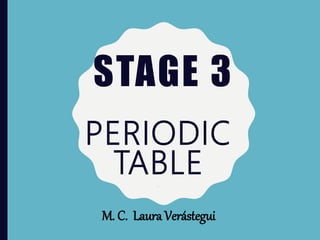
Periodic table
- 1. STAGE 3 PERIODIC TABLE. M. C. Laura Verástegui
- 2. HISTORY OF THE PERIODIC TABLE Law of Triads: In 1817 Johann Döbereiner proposed that nature contained triads of elements the middle element properties that were an average of the other two members when ordered by the atomic weight. Law of Octaves: John Newlands, he classified elements based on similar physical properties, noting that many of similar elements existed which differed by some multiple of eight in atomic weight.
- 3. Lothar Meyer: In 1868 he developed his own version of the periodic table, unfortunately for Meyer, Mendeleev's table became available to the scientific community via publication two years before his work. Dmitri Mendeleev: He is considered the father of the periodic table, he developed a periodic table of the known elements ordered according to their atomic mass and letting spaces for the elements not discovered yet, predicting their properties atomic masses.
- 4. MODERN PERIODIC TABLE Henry Moseley :In 1913, published the results of his measurements of the positive charge of the nucleus the atoms, he concluded that the elements coincided with the ordering of the elements by ascending atomic number. It became apparent that atomic weight was not the significant player in the periodic law as Mendeleev, Meyers and others had proposed, but rather, the properties of the elements varied periodically with atomic number: Periodic Law
- 5. PERIODIC TABLE ORGANIZATION • The periodic table provide a lot of information and is organized in a special arrangement, we may found: • Metal, metalloid and non-metals • Periods • Groups or families • Blocks
- 6. PERIOD: is a horizontal row in the periodic table. Indicate the outermost energy level of the elements. BLOCK: Named according to the subshell in which the "last" electron resides. The s-block comprises the first two groups (alkali metals and alkaline earth metals) as well as hydrogen and helium. The p-block comprises the last six groups (groups 13 through 18) and contains, among others, all of the semimetals. The d- block comprises groups 3 through 12 and contains all of the transition metals. The f-block, usually offset below the rest of the periodic table, comprises the rare earth metals.
- 8. GROUPS • Or family is a vertical column in the periodic table. Groups are considered the most important method of classifying the elements. In some groups, the elements have very similar properties and exhibit a clear trend in properties down the group. These groups tend to be given trivial (unsystematic) names, e.g., the alkali metals, alkaline earth metals, halogens,, chalcogens, and noble gases.
- 10. • Representative elements are those label as A groups: IA – VIIIA –IA: Alkali metals –IIA: Alkali Earth metals –IIIA:Boron family –IVA: Carbon family –VA: Nitrogen family –VIA: Oxygen family or Chalcogens. –VIIA: Halogens –VIIIA: Noble gases. • Group B: All are called transition metals • Lanthanide and actinide series: Rare Earth metals.
- 11. Metalloids or Semimetals: Have similar properties to both metals and non-metals. These elements are located along the zigzag that divide the metals from non-metals: B, Si, Ge, As, Sb, Te, Po, At.
- 13. VALENCE ELECTRONS • Are the outermost electrons of an atom, which are important in determining how the atom reacts chemically with other atoms. They do show a repeating or periodic pattern. The valence electrons increase in number as you go across a period. • Valence electrons are those in the electronic shell of highest principal quantum number. For example the electronic configuration of phosphorus (P) is 1s2 2s2 2p6 3s2 3p3 so that are 5 valence electrons (3s2 3p3),
- 15. OXIDATION NUMBER • Called oxidation state, The apparent charge assigned to an atom within a compound.
- 16. PERIODIC TRENDS • Atomic radii: is a measure of the size of its atoms, usually the distance from the nucleus to the boundary of the surrounding cloud of electrons.
- 17. • Ionization energy: The energy required to remove an electron from an atom or molecule in gas state. • Electronic affinity: The energy absorbed or released when a gaseous atom captures electron. • Electronegativity: a chemical property that describes the ability of an atom to attract electrons from a covalent bond.
- 18. ATOMIC RADII INCREASES IONIZATION E, ELECTRONIC AFF. AND ELECTRONEGATIVITY INCREASES
